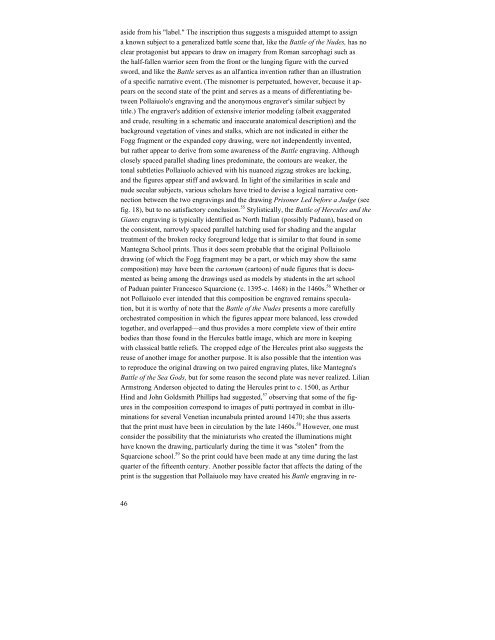Battle of the Nudes
Battle of the Nudes
Battle of the Nudes
You also want an ePaper? Increase the reach of your titles
YUMPU automatically turns print PDFs into web optimized ePapers that Google loves.
aside from his "label." The inscription thus suggests a misguided attempt to assign<br />
a known subject to a generalized battle scene that, like <strong>the</strong> <strong>Battle</strong> <strong>of</strong> <strong>the</strong> <strong>Nudes</strong>, has no<br />
clear protagonist but appears to draw on imagery from Roman sarcophagi such as<br />
<strong>the</strong> half-fallen warrior seen from <strong>the</strong> front or <strong>the</strong> lunging figure with <strong>the</strong> curved<br />
sword, and like <strong>the</strong> <strong>Battle</strong> serves as an all'antica invention ra<strong>the</strong>r than an illustration<br />
<strong>of</strong> a specific narrative event. (The misnomer is perpetuated, however, because it ap-<br />
pears on <strong>the</strong> second state <strong>of</strong> <strong>the</strong> print and serves as a means <strong>of</strong> differentiating be-<br />
tween Pollaiuolo's engraving and <strong>the</strong> anonymous engraver's similar subject by<br />
title.) The engraver's addition <strong>of</strong> extensive interior modeling (albeit exaggerated<br />
and crude, resulting in a schematic and inaccurate anatomical description) and <strong>the</strong><br />
background vegetation <strong>of</strong> vines and stalks, which are not indicated in ei<strong>the</strong>r <strong>the</strong><br />
Fogg fragment or <strong>the</strong> expanded copy drawing, were not independently invented,<br />
but ra<strong>the</strong>r appear to derive from some awareness <strong>of</strong> <strong>the</strong> <strong>Battle</strong> engraving. Although<br />
closely spaced parallel shading lines predominate, <strong>the</strong> contours are weaker, <strong>the</strong><br />
tonal subtleties Pollaiuolo achieved with his nuanced zigzag strokes are lacking,<br />
and <strong>the</strong> figures appear stiff and awkward. In light <strong>of</strong> <strong>the</strong> similarities in scale and<br />
nude secular subjects, various scholars have tried to devise a logical narrative con-<br />
nection between <strong>the</strong> two engravings and <strong>the</strong> drawing Prisoner Led before a Judge (see<br />
fig. 18), but to no satisfactory conclusion. 55 Stylistically, <strong>the</strong> <strong>Battle</strong> <strong>of</strong> Hercules and <strong>the</strong><br />
Giants engraving is typically identified as North Italian (possibly Paduan), based on<br />
<strong>the</strong> consistent, narrowly spaced parallel hatching used for shading and <strong>the</strong> angular<br />
treatment <strong>of</strong> <strong>the</strong> broken rocky foreground ledge that is similar to that found in some<br />
Mantegna School prints. Thus it does seem probable that <strong>the</strong> original Pollaiuolo<br />
drawing (<strong>of</strong> which <strong>the</strong> Fogg fragment may be a part, or which may show <strong>the</strong> same<br />
composition) may have been <strong>the</strong> cartonum (cartoon) <strong>of</strong> nude figures that is docu-<br />
mented as being among <strong>the</strong> drawings used as models by students in <strong>the</strong> art school<br />
<strong>of</strong> Paduan painter Francesco Squarcione (c. 1395-c. 1468) in <strong>the</strong> 1460s. 56 Whe<strong>the</strong>r or<br />
not Pollaiuolo ever intended that this composition be engraved remains specula-<br />
tion, but it is worthy <strong>of</strong> note that <strong>the</strong> <strong>Battle</strong> <strong>of</strong> <strong>the</strong> <strong>Nudes</strong> presents a more carefully<br />
orchestrated composition in which <strong>the</strong> figures appear more balanced, less crowded<br />
toge<strong>the</strong>r, and overlapped—and thus provides a more complete view <strong>of</strong> <strong>the</strong>ir entire<br />
bodies than those found in <strong>the</strong> Hercules battle image, which are more in keeping<br />
with classical battle reliefs. The cropped edge <strong>of</strong> <strong>the</strong> Hercules print also suggests <strong>the</strong><br />
reuse <strong>of</strong> ano<strong>the</strong>r image for ano<strong>the</strong>r purpose. It is also possible that <strong>the</strong> intention was<br />
to reproduce <strong>the</strong> original drawing on two paired engraving plates, like Mantegna's<br />
<strong>Battle</strong> <strong>of</strong> <strong>the</strong> Sea Gods, but for some reason <strong>the</strong> second plate was never realized. Lilian<br />
Armstrong Anderson objected to dating <strong>the</strong> Hercules print to c. 1500, as Arthur<br />
Hind and John Goldsmith Phillips had suggested, 57 observing that some <strong>of</strong> <strong>the</strong> fig-<br />
ures in <strong>the</strong> composition correspond to images <strong>of</strong> putti portrayed in combat in illu-<br />
minations for several Venetian incunabula printed around 1470; she thus asserts<br />
that <strong>the</strong> print must have been in circulation by <strong>the</strong> late 1460s. 58 However, one must<br />
consider <strong>the</strong> possibility that <strong>the</strong> miniaturists who created <strong>the</strong> illuminations might<br />
have known <strong>the</strong> drawing, particularly during <strong>the</strong> time it was "stolen" from <strong>the</strong><br />
Squarcione school. 59 So <strong>the</strong> print could have been made at any time during <strong>the</strong> last<br />
quarter <strong>of</strong> <strong>the</strong> fifteenth century. Ano<strong>the</strong>r possible factor that affects <strong>the</strong> dating <strong>of</strong> <strong>the</strong><br />
print is <strong>the</strong> suggestion that Pollaiuolo may have created his <strong>Battle</strong> engraving in re-<br />
46
















